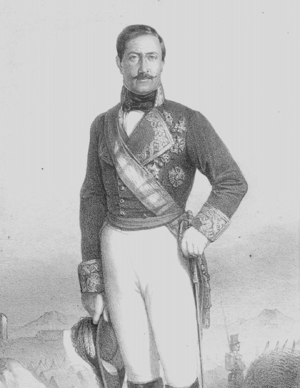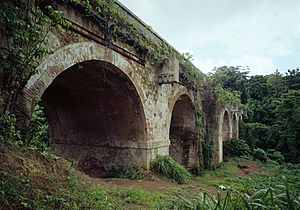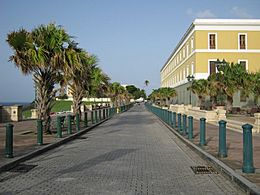Fernándo Norzagaray y Escudero facts for kids
Quick facts for kids
Fernando Norzagaray
|
|
|---|---|
 |
|
| 78th Governor-General of the Philippines | |
| In office 9 March 1857 – 12 January 1860 |
|
| Monarch | Isabella II of Spain |
| Preceded by | Ramón Montero |
| Succeeded by | Ramón María Solano |
| 104th Governor of Puerto Rico | |
| In office May 1852 – January 1855 |
|
| Preceded by | Enrique de España y Taberner |
| Succeeded by | Andrés García Gamba |
| Personal details | |
| Born |
Fernando María Félix Mateo Juan Nepomuceno de Norzagaray y Escudero
19 July 1808 San Sebastián, Spain |
| Died | 12 September 1860 (aged 52) Madrid, Spain |
| Military service | |
| Allegiance | |
| Rank | Lieutenant-General |
Fernando Norzagaray (born July 19, 1808 – died September 12, 1860) was an important Spanish soldier and leader. He served as a governor for Spain in two different places: Puerto Rico and the Philippines. He was also involved in politics back in Spain.
Norzagaray was a high-ranking soldier, a lieutenant general. He became the 104th Governor of Puerto Rico. Later, he was the 78th Governor of the Philippines under Spanish rule. He also briefly served as Spain's Minister of War in 1840.
Contents
Early Life and Military Career
Fernando Norzagaray was born on July 19, 1808, in San Sebastián, Spain. His father was also a military officer. This meant Fernando grew up in a family connected to the army.
He rose through the ranks in the Spanish military. Eventually, he became a lieutenant general, which is a very senior position.
Governing Puerto Rico

Norzagaray served as the Governor of Puerto Rico from 1852 to 1855. During his time there, he focused on building important things for the island.
He worked on many infrastructure projects. For example, the General Norzagaray Bridge was built during his term. This bridge crosses the Los Frailes stream. He also helped build arsenals (places to store weapons) and created a cavalry unit (soldiers who fight on horseback).
Leading the Philippines
Norzagaray became the Governor of the Philippines in 1857. He made several changes and improvements during his time there.
Just two months after becoming governor, he allowed foreign currency exchange houses to open. This helped with trade and money matters. He also made changes to how local areas were managed in September 1858. He improved the organization of the infantry (foot soldiers) in 1859.
In 1859, a group of Jesuit priests returned to the Philippines. Norzagaray gave them the Escuela Municipal, which was the only primary school in Manila at the time. He also started a botanical garden in 1858. This garden is now known as Mehan Garden.
The Cochinchina Campaign
In 1858, Governor Norzagaray sent troops from the Philippines to Cochinchina. This area is in southern Vietnam. This was a joint military effort with France.
Both Spain and France said they were protecting Catholicism in Vietnam. Spain was reacting to the execution of a bishop there. The expedition hoped to increase trade for the Philippines in Asia. However, Spain and its colony did not gain much from this four-year campaign.
Spanish forces, including 1,000 troops from the Philippines, joined the French. They fought in battles like the Siege of Tourane and the Siege of Saigon. The combined forces won the Siege of Saigon.
By 1860, most of the Spanish troops were called back. France continued to develop its own colony in Vietnam.
Norzagaray's Legacy
Fernando Norzagaray left a lasting mark in the places he governed.
In the Philippines, a town was renamed in his honor. The town of Casay became known as Norzagaray. He had separated Casay from another town, Angat, making it its own distinct town.
In Old San Juan Historic District, Puerto Rico, a street is named Calle Norzagaray.
Gallery
See also
 In Spanish: Fernando de Norzagaray para niños
In Spanish: Fernando de Norzagaray para niños




